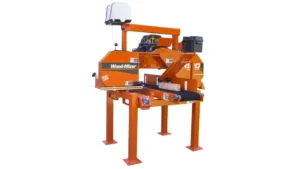
DoubleHard Bandsaw Blades
$97.10 – $127.10Price range: $97.10 through $127.10
+1(213)267-2305
26 ip4 smatstill Road
mjsawmillslumber22@gmail.com
$97.10 – $127.10Price range: $97.10 through $127.10
Sawmill Blade Material Selection Guide
Most Affordable

SilverTip Carbon Steel
Most Popular

DoubleHard High-Alloy Steel
Specialty

BiMetal Two-Piece Steel
Specialty

RazorTip Carbide Steel
Sawmill Blade Thickness

Thickness is the thickness of the body of the sawmill blade without including tooth set.
Sawmill Blade Hook Angle

Hook angle is the number of degrees that the tooth face leans forward of 90 degrees.
Back angle is the number of degrees that the backside of the tooth leans backward of 90 degrees.
The hook angle and back angle of a sawmill blade should be chosen based on the type of wood you are sawing and what type of equipment you are sawing with.
Sawmill Blade Tooth Spacing

Tooth spacing is the distance between each tooth from one tip to another. The pitch of a sawmill blade is also used in reference to tooth spacing as the number of teeth per inch or TPI on a bandsaw blade.
| Length | 125"+($19.14), 132", 144"+($1.32), 158"($18.80), 167+($22.28), 171"(+$25.27), 176"+(28.75), 184"+($84.58), 195"+($94.88), 205"+($47.30) |
|---|---|
| Thickness x Width | 0.042" X 11/4" |
| Hook Angle | 10 All-Purpose(Most Popular), 7 Hardwood+$247.20, Turbo 739 Hardwood/High Horsepower+$263.70, Turbo 747 All-Purpose/All Horsepower+$263.70 |
| Tooth Spacing | 7/8" |



Manufactured from the most common and affordable carbon steel material, SilverTip carbon steel sawmill blades are recommended for economical sawing on portable and industrial sawmills or for high-volume sawmills and resaws. Compared to most standard carbon steel sawmill blades, SilverTip is made with a higher carbon content with highdurability steel for better performance.



– Mark H., –
I’ve been using the DoubleHard Bandsaw Blades for over a year now, and they have truly exceeded my expectations. The blades are incredibly durable and maintain their sharpness even after extensive use. They make clean, precise cuts every time, saving me both time and money on replacements. Highly recommended for anyone in the sawmill business!
– Sarah J., –
The DoubleHard Bandsaw Blades are the best investment I’ve made for my mill. They offer a perfect balance between toughness and cutting efficiency, handling hardwoods with ease. I’ve seen a significant increase in productivity since switching to these blades. They’re a game-changer for any serious woodworker!